The Interregional Embodied Oil Transfer in China: Estimation and Path Structure Decomposition
Abstract
1. Introduction
2. Literature Review
2.1. Research on Embodied Oil Flows
2.2. Application of Input–Output Model in Embodied Energy Research
3. Methodology and Data Sources
3.1. Methodology
3.1.1. Measurement of Interregional Embodied Oil Transfer Scale in China
3.1.2. Structural Decomposition of Interregional Transferred Embodied Oil Path
3.2. Data Sources
4. Main Results
4.1. Estimation of Interregional Transferred Embodied Oil Scale in China
4.1.1. Interprovincial Transferred Embodied Oil
4.1.2. Interindustrial Transferred Embodied Oil
4.2. The Path Structure of Interregional Transferred Embodied Oil in China
4.2.1. The Structure of Sources
4.2.2. The Structure of Supply and Demand
4.2.3. The Structure of Distribution in National Value Chains
5. Discussion
5.1. Balanced Interprovincial Transfers and Concentrated Interindustrial Transfers
5.2. Critical Demanders, Suppliers, and Intermediaries in Interregional Embodied Oil Transfers
5.3. The Importance of Interregional Trade in the Transfer of Embodied Oil
6. Conclusions and Policy Implications
Author Contributions
Funding
Data Availability Statement
Conflicts of Interest
References
- Chen, B.; Li, J.S.; Wu, X.F.; Han, M.Y.; Zeng, L.; Li, Z.; Chen, G.Q. Global energy flows embodied in international trade: A combination of environmentally extended input-output analysis and complex network analysis. Appl. Energy 2018, 210, 98–107. [Google Scholar] [CrossRef]
- Wang, Q.; Jiang, F. Drivers of United States oil footprints trajectory: A global assessment. J. Clean. Prod. 2019, 240, 118150. [Google Scholar] [CrossRef]
- Zhang, W.; Wei, R.; Peng, S. The oil-slick trade: An analysis of embodied crude oil in China’s trade and consumption. Energy Econ. 2020, 88, 104763. [Google Scholar] [CrossRef]
- Zhang, C.; Dong, M. China’s embodied oil outflow: Estimation and structural path analysis. Environ. Dev. Sustain. 2022, 25, 14861–14885. [Google Scholar] [CrossRef]
- Ji, Q.; Zhang, H.-Y.; Fan, Y. Identification of Global Oil Trade Patterns: An Empirical Research Based on Complex Network Theory. Energy Convers. Manag. 2014, 85, 856–865. [Google Scholar] [CrossRef]
- Jia, X.; An, H.; Sun, X.; Huang, X.; Wang, L. Evolution of world crude oil market integration and diversification: A wavelet-based complex network perspective. Appl. Energy 2017, 185, 1788–1798. [Google Scholar] [CrossRef]
- Yang, Y.; Poon, J.P.H.; Liu, Y.; Bagchi-Sen, S. Small and flat worlds: A complex network analysis of international trade in crude oil. Energy 2015, 93, 534–543. [Google Scholar] [CrossRef]
- Costanza, R. Embodied Energy and Economic Valuation. Science 1980, 210, 1219–1224. [Google Scholar] [CrossRef]
- Odum, H.T. Self-Organization, Transformity, and Information. Science 1988, 242, 1132–1139. [Google Scholar] [CrossRef]
- Chen, J.; Zhou, W.; Yang, H. Is Embodied Energy a Better Starting Point for Solving Energy Security Issues?—Based on an Overview of Embodied Energy-Related Research. Sustainability 2019, 11, 4260. [Google Scholar] [CrossRef]
- Liu, B.; Zhang, L.; Sun, J.; Wang, D.; Liu, C.; Luther, M.; Xu, Y. Analysis and comparison of embodied energies in gross exports of the construction sector by means of their value-added origins. Energy 2020, 191, 116546. [Google Scholar] [CrossRef]
- Tang, X.; Zhang, B.; Feng, L.; Snowden, S.; Höök, M. Net oil exports embodied in China’s international trade: An input–output analysis. Energy 2012, 48, 464–471. [Google Scholar] [CrossRef]
- Wiedmann, T.O. A review of recent multi-region input–output models used for consumption-based emission and resource accounting. Ecol. Econ. 2009, 69, 211–222. [Google Scholar] [CrossRef]
- Hong, J.; Tang, M.; Wu, Z.; Miao, Z.; Shen, G.Q. The evolution of patterns within embodied energy flows in the Chinese economy: A multi-regional-based complex network approach. Sustain. Cities Soc. 2019, 47, 101500. [Google Scholar] [CrossRef]
- Su, B.; Ang, B.W. Input–output analysis of CO2 emissions embodied in trade: The effects of spatial aggregation. Ecol. Econ. 2010, 70, 10–18. [Google Scholar] [CrossRef]
- Hong, J.; Gu, J.; Liang, X.; Liu, G.; Shen, G.Q. Characterizing embodied energy accounting with a multi-dimensional framework: A study of China’s building sector. J. Clean. Prod. 2019, 215, 154–164. [Google Scholar] [CrossRef]
- Su, B.; Ang, B.W.; Li, Y. Structural path and decomposition analysis of aggregate embodied energy and emission intensities. Energy Econ. 2019, 83, 345–360. [Google Scholar] [CrossRef]
- Jiang, L.; He, S.; Tian, X.; Zhang, B.; Zhou, H. Energy use embodied in international trade of 39 countries: Spatial transfer patterns and driving factors. Energy 2020, 195, 116988. [Google Scholar] [CrossRef]
- Su, B.; Ang, B.W. Structural decomposition analysis applied to energy and emissions: Some methodological developments. Energy Econ. 2012, 34, 177–188. [Google Scholar] [CrossRef]
- Gao, C.; Su, B.; Sun, M.; Zhang, X.; Zhang, Z. Interprovincial transfer of embodied primary energy in China: A complex network approach. Appl. Energy 2018, 215, 792–807. [Google Scholar] [CrossRef]
- Shi, J.; Li, H.; Guan, J.; Sun, X.; Guan, Q.; Liu, X. Evolutionary features of global embodied energy flow between sectors: A complex network approach. Energy 2017, 140, 395–405. [Google Scholar] [CrossRef]
- Tang, M.; Hong, J.; Liu, G.; Shen, G.Q. Exploring energy flows embodied in China’s economy from the regional and sectoral perspectives via combination of multi-regional input–output analysis and a complex network approach. Energy 2019, 170, 1191–1201. [Google Scholar] [CrossRef]
- Kan, S.; Chen, B.; Chen, G. Worldwide energy use across global supply chains: Decoupled from economic growth? Appl. Energy 2019, 250, 1235–1245. [Google Scholar] [CrossRef]
- Wu, X.F.; Chen, G. Global primary energy use associated with production, consumption and international trade. Energy Policy 2017, 111, 85–94. [Google Scholar] [CrossRef]
- Wu, X.F.; Chen, G.Q. Global overview of crude oil use: From source to sink through inter-regional trade. Energy Policy 2019, 128, 476–486. [Google Scholar] [CrossRef]
- Song, Z.; Zhu, Q.; Han, M. Tele-connection of global crude oil network: Comparisons between direct trade and embodied flows. Energy 2021, 217, 119359. [Google Scholar] [CrossRef]
- Zhang, X.; Su, B.; Yang, J.; Cong, J. Analysis of Shanxi Province’s energy consumption and intensity using input-output framework (2002–2017). Energy 2022, 250, 123786. [Google Scholar] [CrossRef]
- Wang, Z.; Wei, S.-J.; Zhu, K. Quantifying International Production Sharing at the Bilateral and Sector Levels; National Bureau of Economic Research Working Paper Series No. 19677; National Bureau of Economic Research: Cambridge, MA, USA, 2013. [Google Scholar]
- Pan, W.; Li, G. National Value Chain and Global Value Chain in Chinese Regions: Regional Interaction and Value-Added Gains. Econ. Res. J. 2018, 3, 171–186. [Google Scholar]
- Koopman, R.; Wang, Z.; Wei, S.-J. Tracing Value-Added and Double Counting in Gross Exports. Am. Econ. Rev. 2014, 104, 459–494. [Google Scholar] [CrossRef]
- Wang, Z.; Wei, S.; Zhu, K. Gross Trade Accounting Method: Official Trade Statistics and Measurement of the Global Value Chain. China Soc. Sci. 2015, 9, 108–127, 205–206. [Google Scholar]
- Ran, C.; Xu, X.; Zhang, S. Embodied carbon emissions transfers via inter-regional trade: Evidence from value-added extended decomposition model in China. Heliyon 2022, 8, e10521. [Google Scholar] [CrossRef]
- Wang, Z.; Wei, S.-J.; Yu, X.; Zhu, K. Measures of Participation in Global Value Chains and Global Business Cycles; National Bureau of Economic Research Working Paper Series No. 23222; National Bureau of Economic Research: Cambridge, MA, USA, 2017. [Google Scholar]

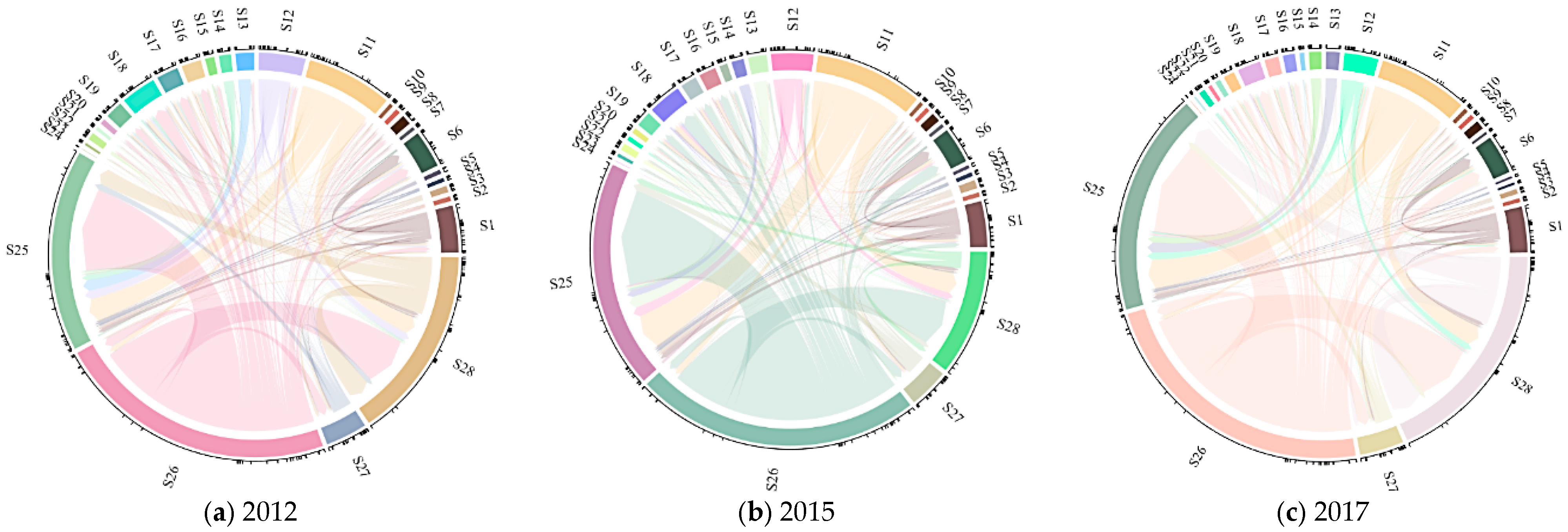
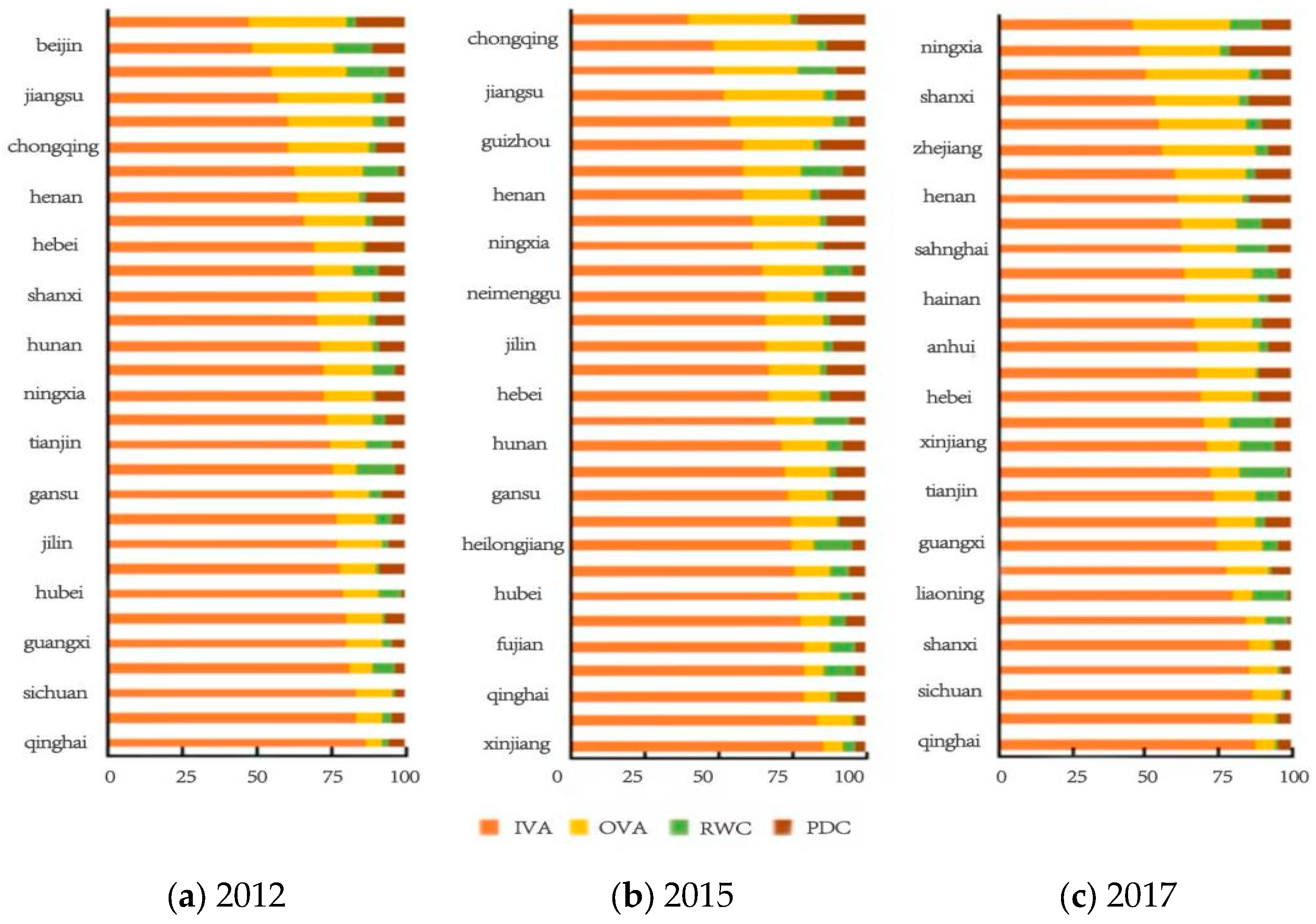
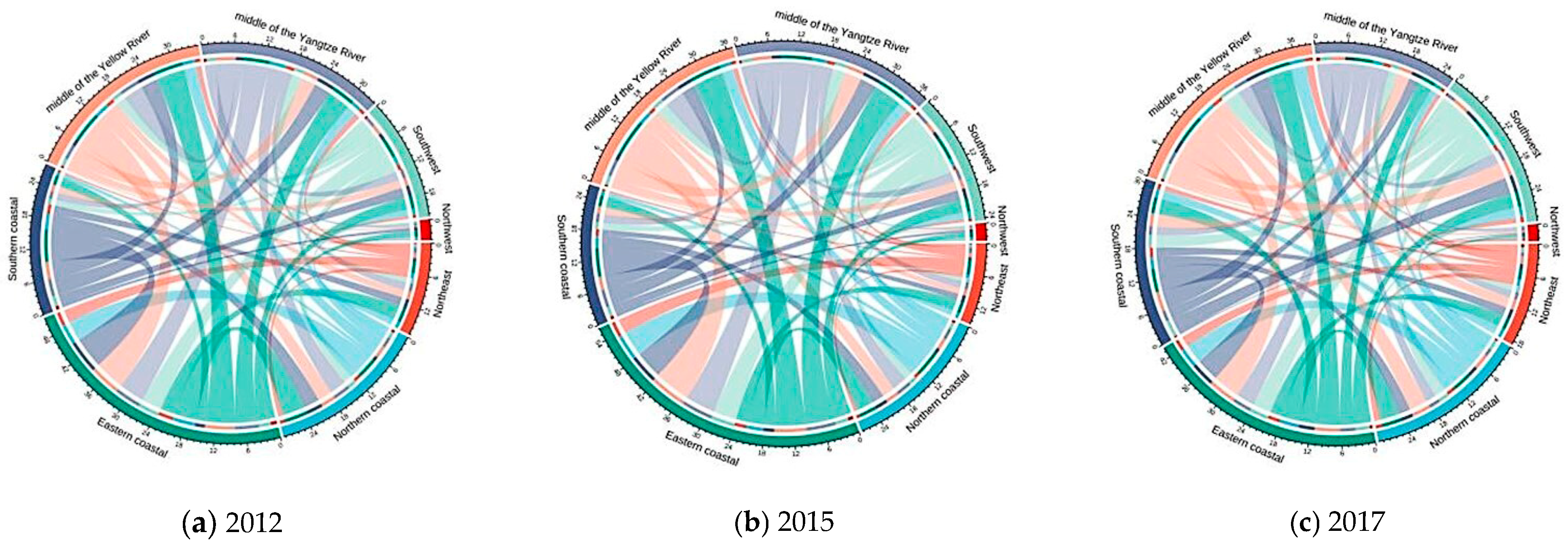
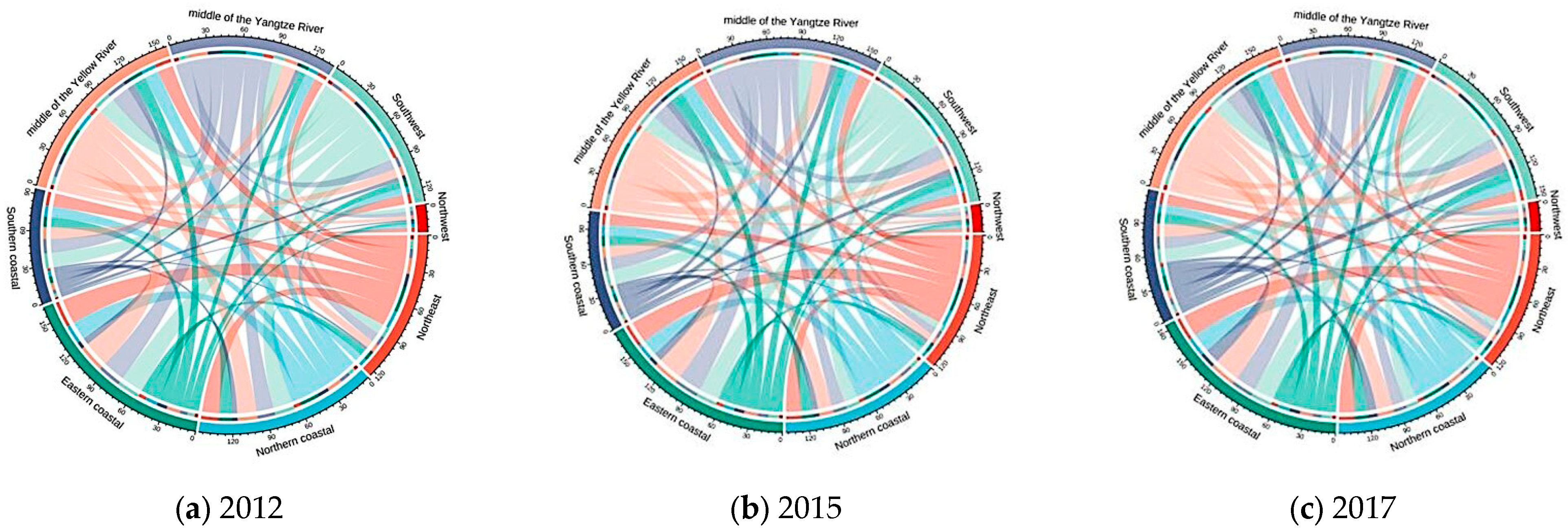
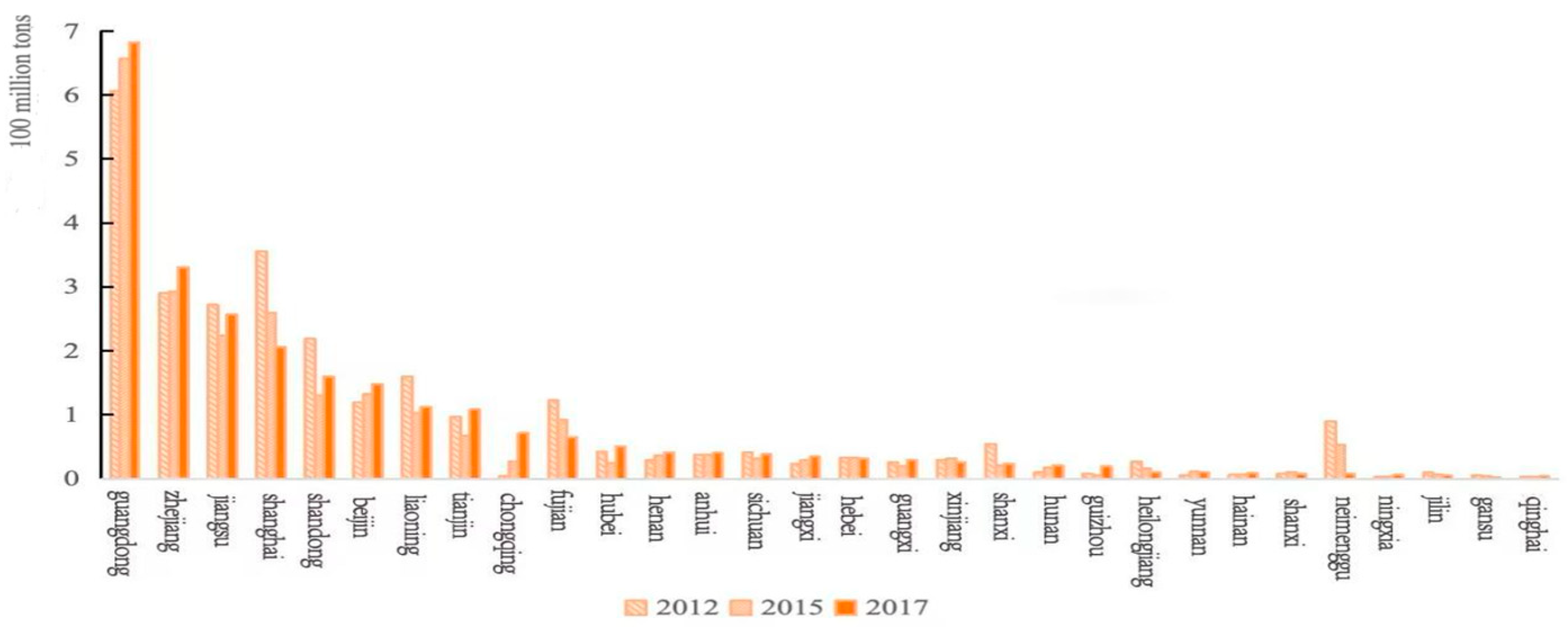
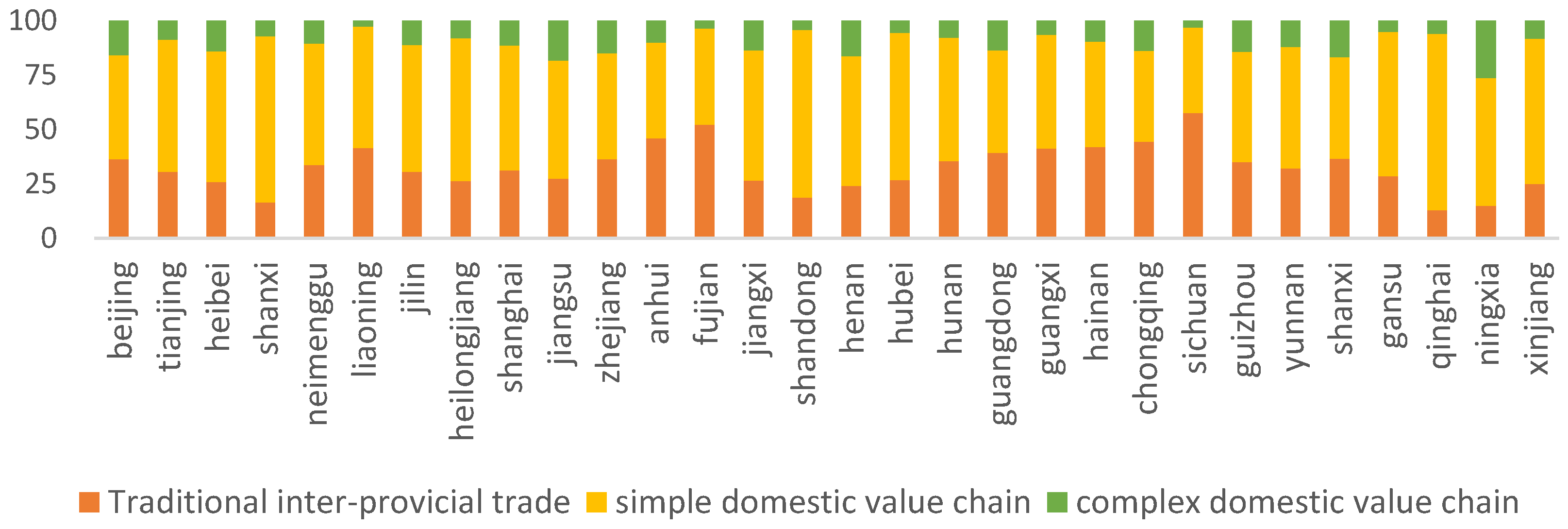
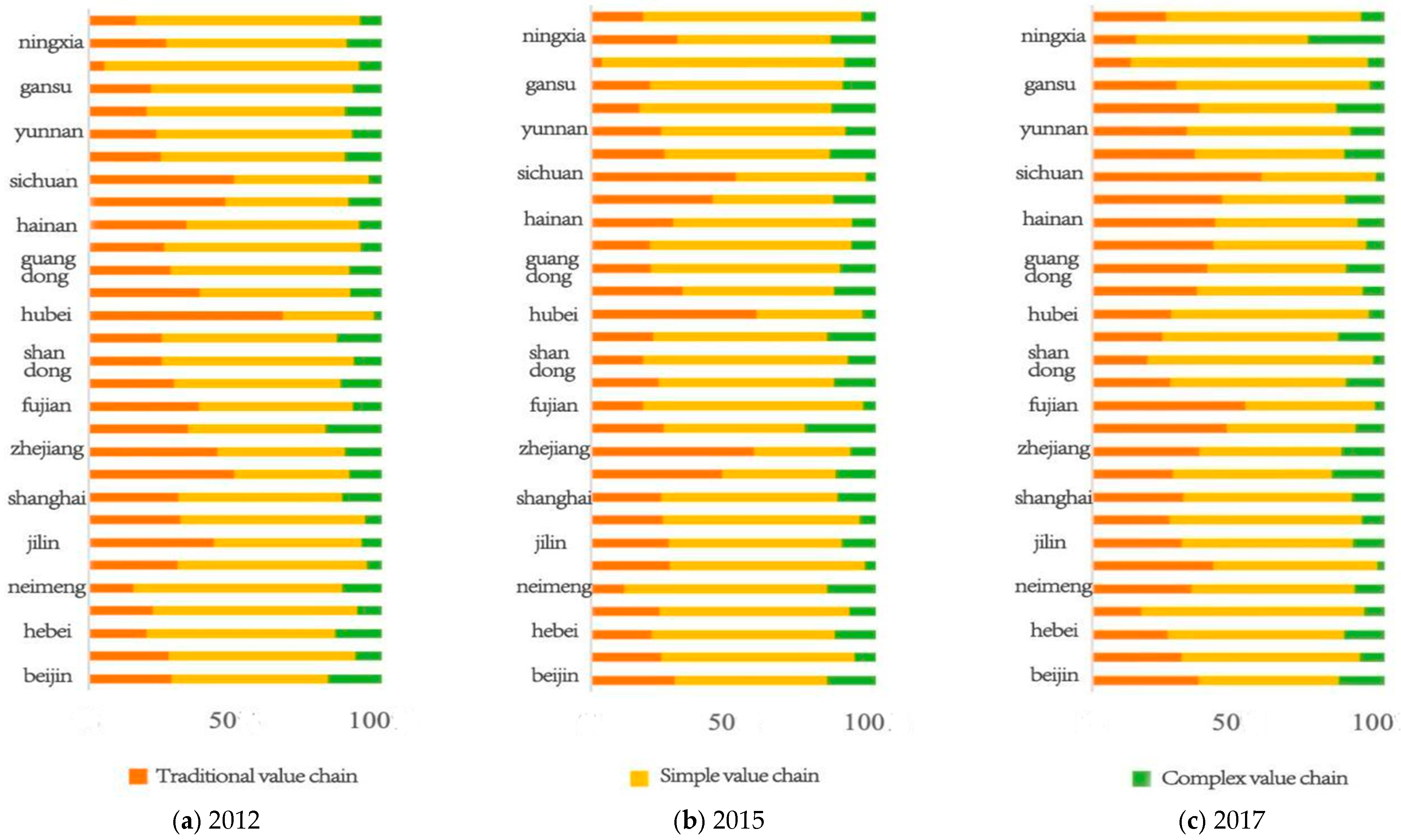
| Terms | Meanings |
|---|---|
| V1 | The embodied oil contained in the final products exported from region s to region r. |
| V2 | The embodied oil contained in the intermediate products that flow from region s to region r and are finally consumed in the non-s region. |
| V3 | The embodied oil contained in the intermediate products that flow from region s to region r and return to region s for consumption. |
| V4 | The embodied oil contained in the intermediate products that flow from region s to region r and then return to region s to produce final products for export, which belongs to double counting. |
| V5 | Double counting of the embodied oil contained in the intermediate products flowing from region s to region r. |
| V6 | The embodied oil contained in the intermediate products exported to foreign countries after flowing from region s to region r. |
| V7 | The embodied oil from China’s non-s region contained in the final products flowing from region s to region r. |
| V8 | The embodied oil from China’s non-s region contained in the intermediate products flowing from region s to region r. |
| V9 | Repeated calculation of the embodied oil from China’s non-s region. |
| Decomposition Terms | Index | Meanings |
|---|---|---|
| V1, V2, V3, V6, V10 | IVA | Embodied oil from region s |
| V7, V8, V11 | OVA | Embodied oil from other regions in China |
| M1-M3, M6-M8, M10, M11 | RWC | Embodied oil from overseas |
| V4, V5, M4, M5, V9, M9 | PDC | Double measurement terms |
| Decomposition Terms | Index |
|---|---|
| V3 | Flow back to original region |
| V1, V7 | Traditional value chain |
| V2, V8 | Simple national value chain |
| V4, V5, V9 | Complex national value chain |
| V6, V10, V11 | Exports to overseas |
| Code | Industry Name | Code | Industry Name |
|---|---|---|---|
| S1 | Agriculture, Hunting, Forestry and Fishing | S15 | Metal Products |
| S2 | Coal Mining and Dressing | S16 | Ordinary Machinery |
| S3 | Petroleum and Natural Gas Extraction | S17 | Equipment for Special Purpose |
| S4 | Ferrous Metals Mining and Dressing | S18 | Transportation Equipment |
| S5 | Nonferrous Metals and Other Minerals Mining and Dressing | S19 | Electric Equipment and Machinery |
| S6 | Food, Beverage and Tobacco Processing | S20 | Electronic and Telecommunications Equipment |
| S7 | Textile Industry | S21 | Other Manufacturing Industry, Scrap and Waste |
| S8 | Garments and Other Fiber Products, Leather, Furs, Down and Related Products | S22 | Electric Power, Steam and Hot Water Production and Supply |
| S9 | Timber Processing, Bamboo, Cane, Palm and Straw Products and Furniture Manufacturing | S23 | Gas Production and Supply |
| S10 | Papermaking and Paper Products, Printing, Record Medium Reproduction, and Cultural, Educational and Sports Articles | S24 | Tap Water Production and Supply |
| S11 | Petroleum Processing and Coking | S25 | Construction |
| S12 | Raw Chemical Materials and Chemical Products | S26 | Transport, Storage, Postal and Telecommunications Services |
| S13 | Nonmetal Mineral Products | S27 | Wholesale, Retail Trade, and Catering Service |
| S14 | Smelting and Pressing of Metals | S28 | Other Services |
Disclaimer/Publisher’s Note: The statements, opinions and data contained in all publications are solely those of the individual author(s) and contributor(s) and not of MDPI and/or the editor(s). MDPI and/or the editor(s) disclaim responsibility for any injury to people or property resulting from any ideas, methods, instructions or products referred to in the content. |
© 2025 by the authors. Licensee MDPI, Basel, Switzerland. This article is an open access article distributed under the terms and conditions of the Creative Commons Attribution (CC BY) license (https://creativecommons.org/licenses/by/4.0/).
Share and Cite
Zhang, C.; Zhou, S.; Yu, X.; Su, R. The Interregional Embodied Oil Transfer in China: Estimation and Path Structure Decomposition. Energies 2025, 18, 2070. https://doi.org/10.3390/en18082070
Zhang C, Zhou S, Yu X, Su R. The Interregional Embodied Oil Transfer in China: Estimation and Path Structure Decomposition. Energies. 2025; 18(8):2070. https://doi.org/10.3390/en18082070
Chicago/Turabian StyleZhang, Chuanguo, Sirui Zhou, Xiaoxue Yu, and Ruiqi Su. 2025. "The Interregional Embodied Oil Transfer in China: Estimation and Path Structure Decomposition" Energies 18, no. 8: 2070. https://doi.org/10.3390/en18082070
APA StyleZhang, C., Zhou, S., Yu, X., & Su, R. (2025). The Interregional Embodied Oil Transfer in China: Estimation and Path Structure Decomposition. Energies, 18(8), 2070. https://doi.org/10.3390/en18082070






